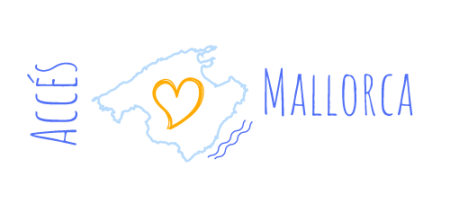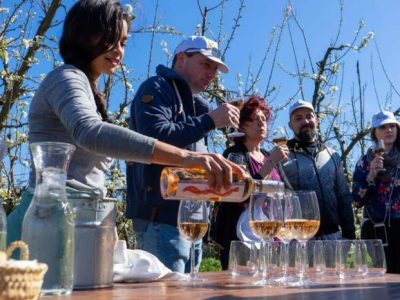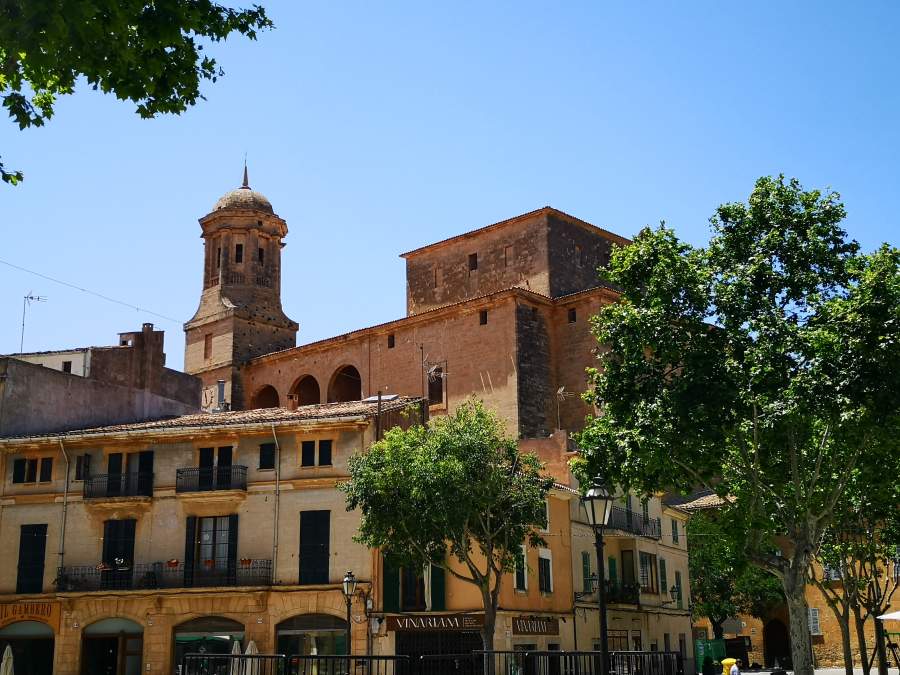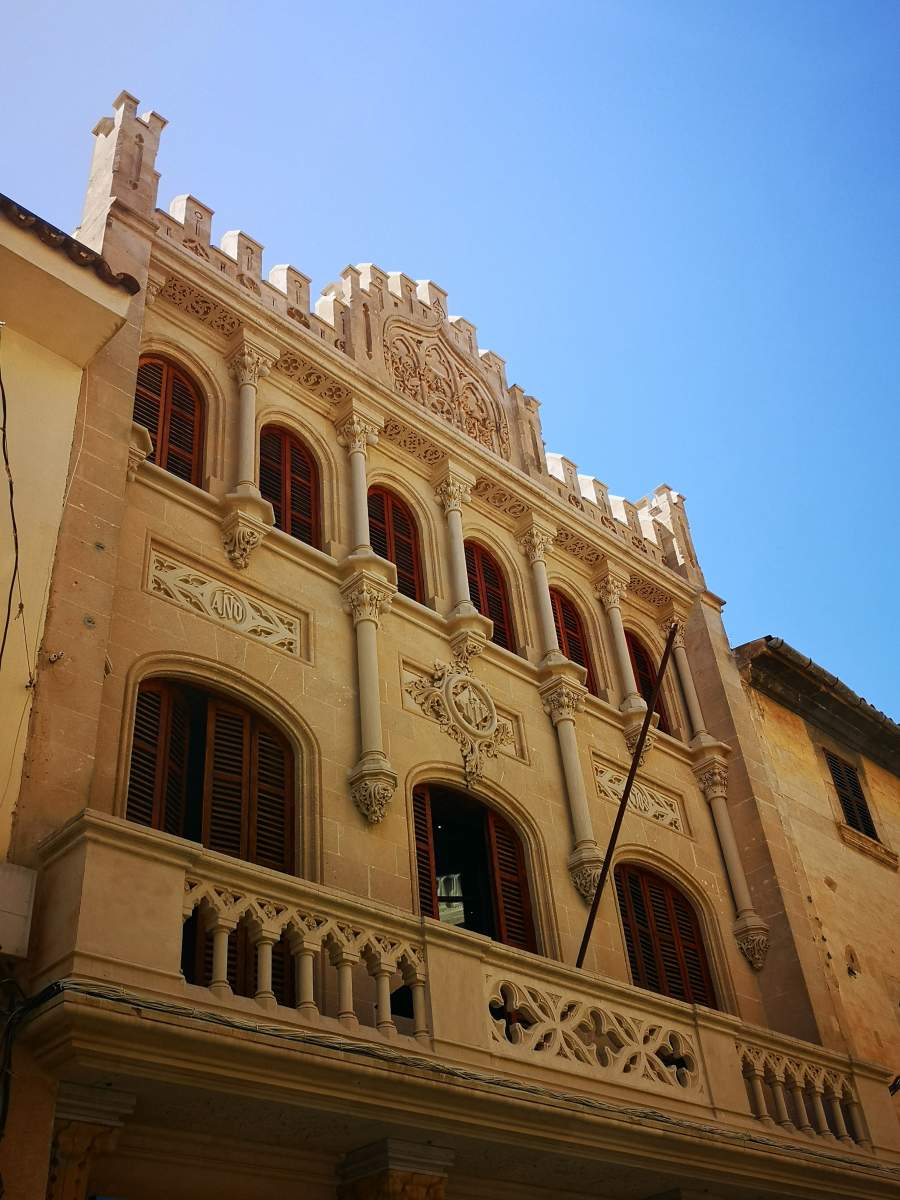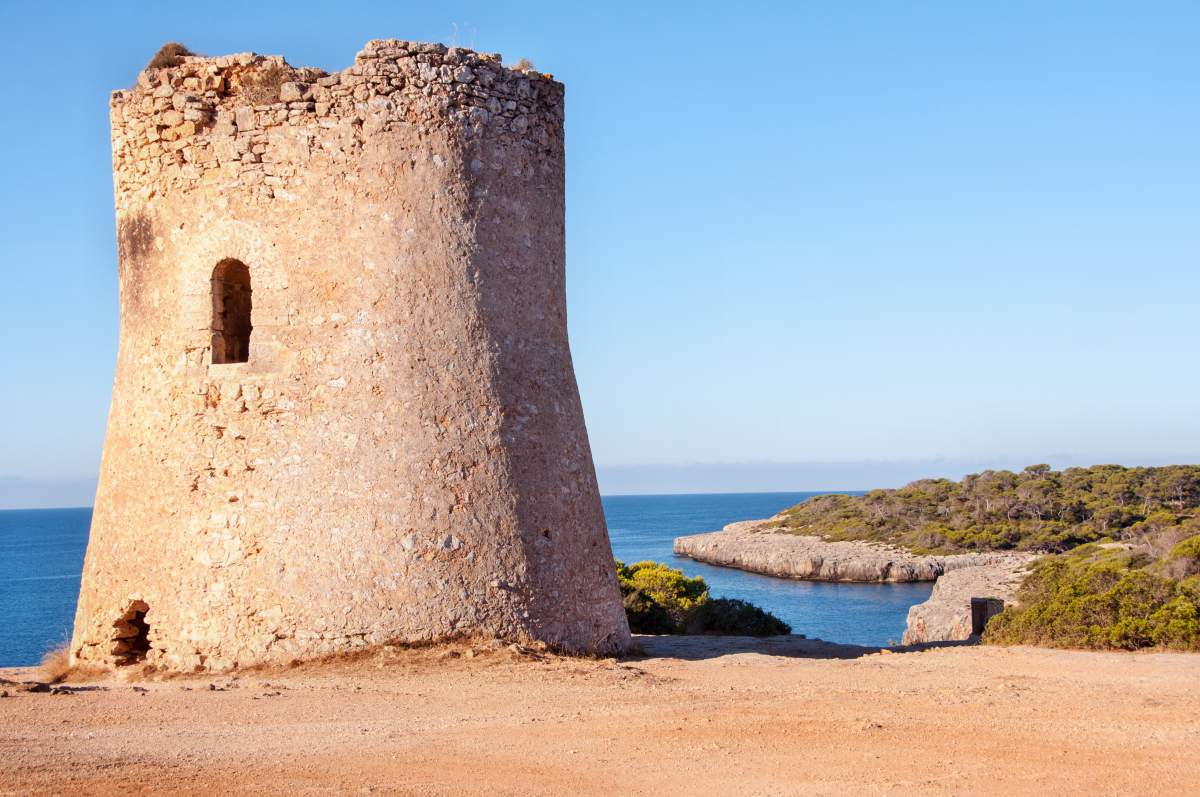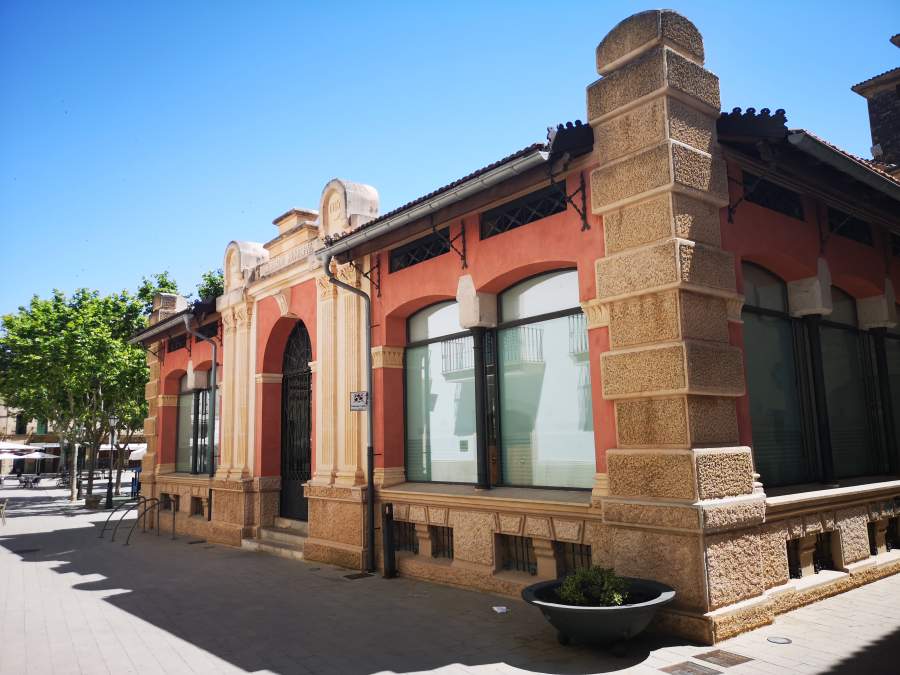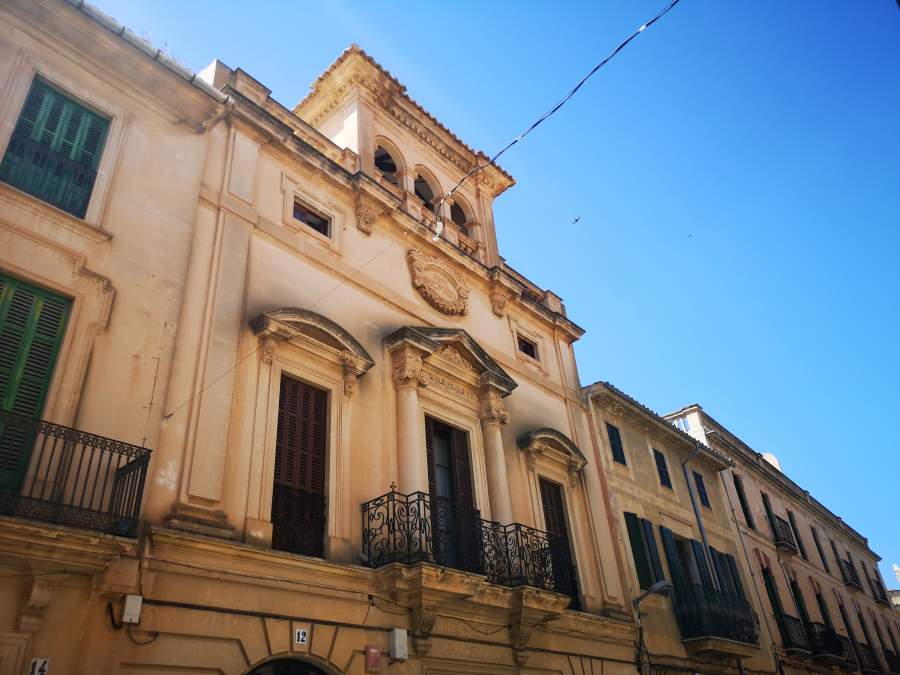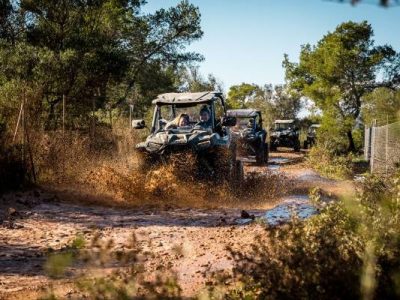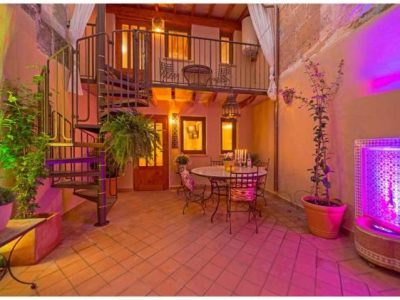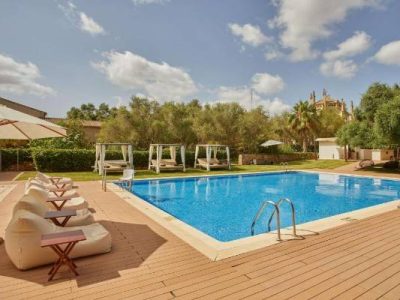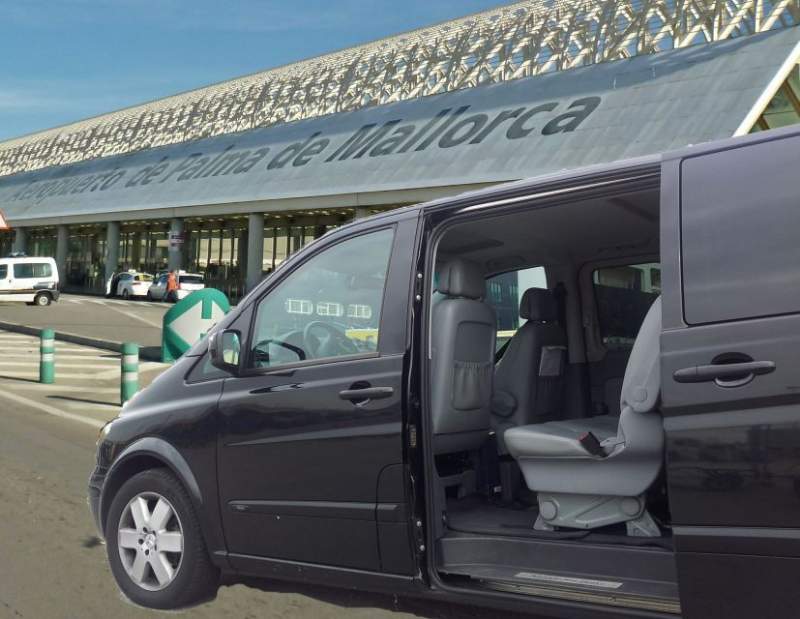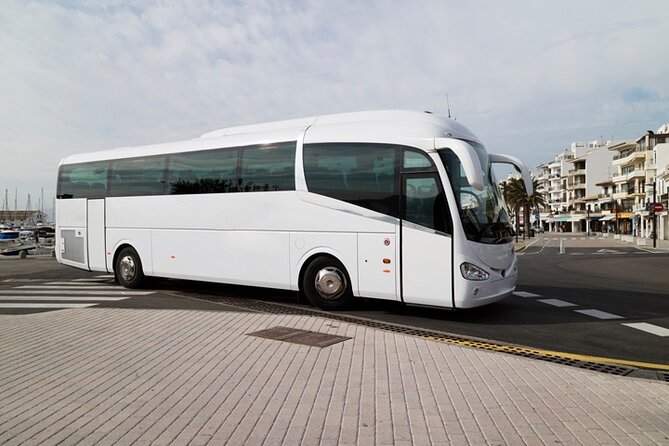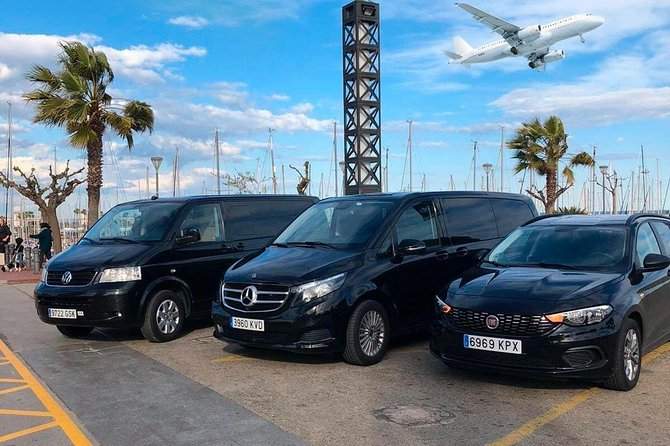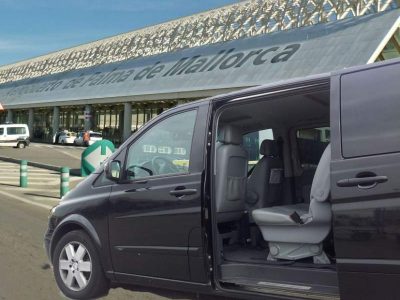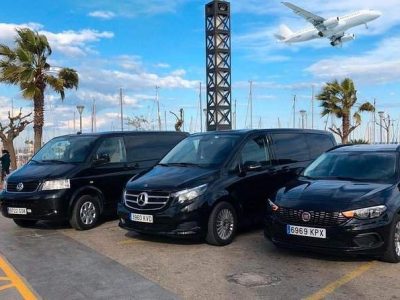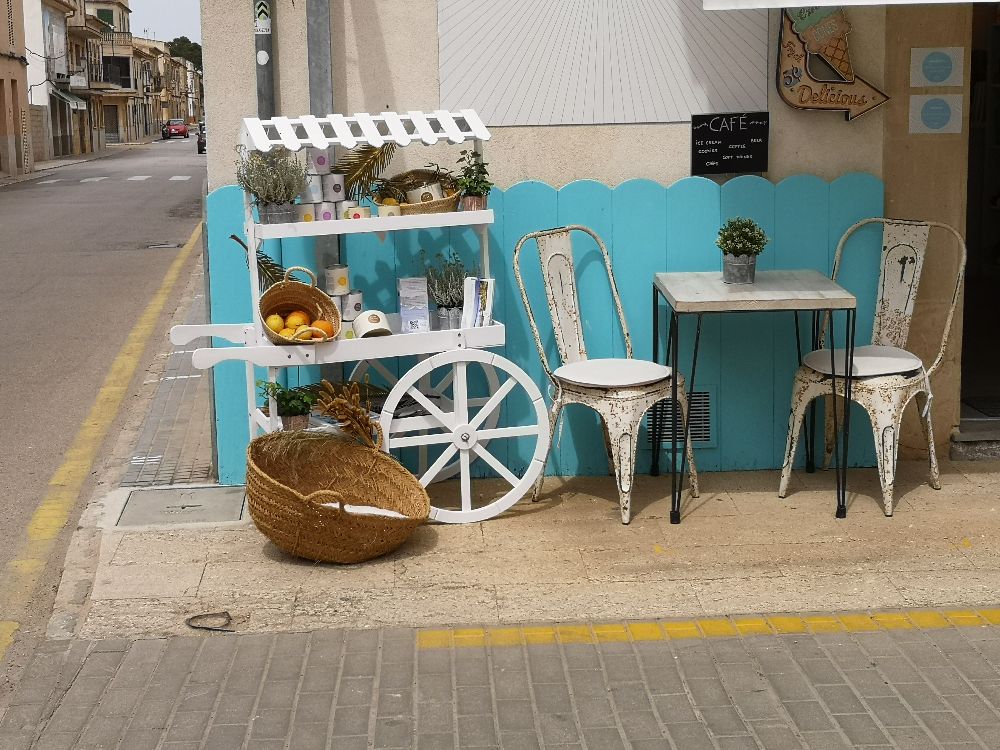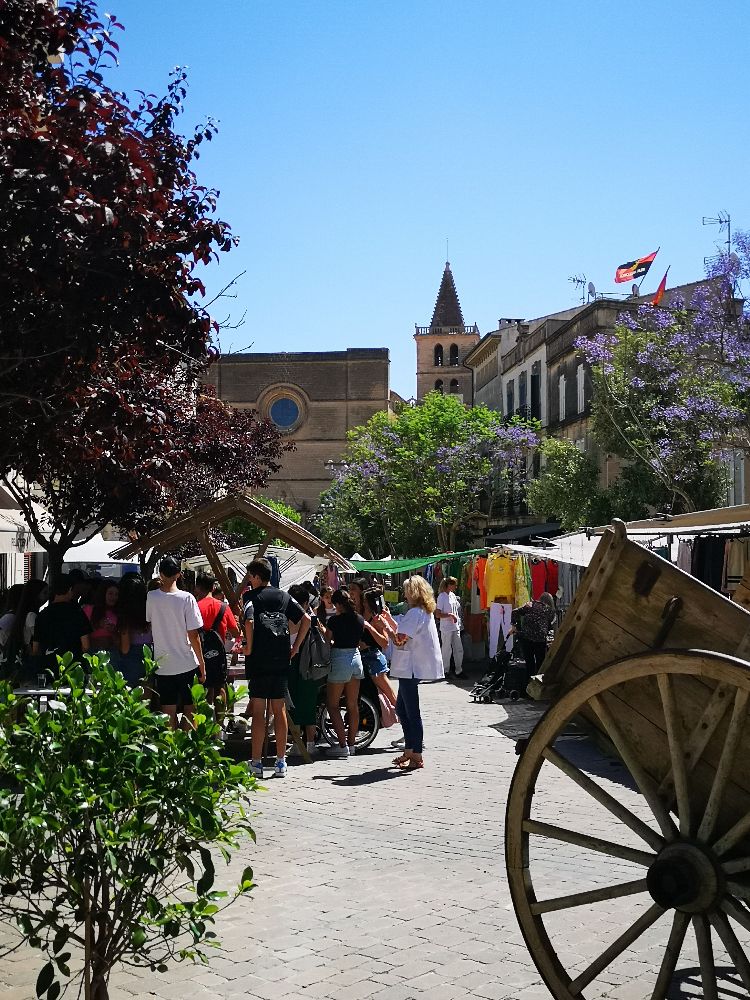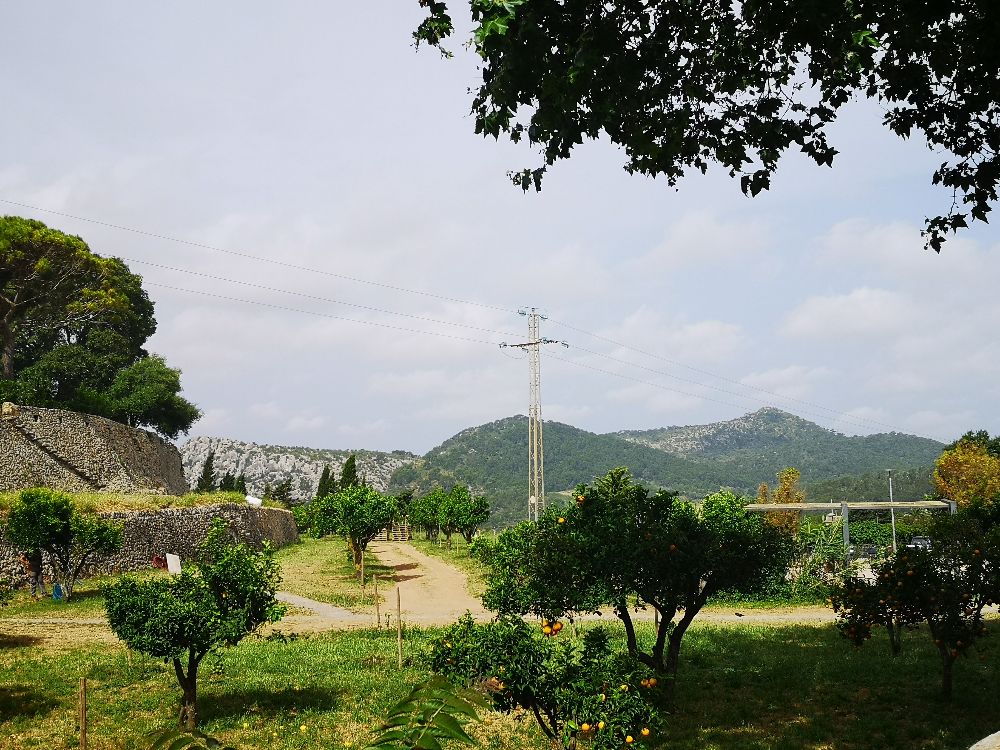All your holiday planning needs in one place, letting you book direct and benefit from official online rates
- Places To Go
- Things To Do
What’s Your Interest?
Traveling with kids
- Blog
Llucmajor, Mallorca - A Guide to Sights and area
Llucmajor is a large municipality located east of Palma which, in addition to the town itself, is also home to the popular s’Arenal beach resort.
- This is where I want to go!
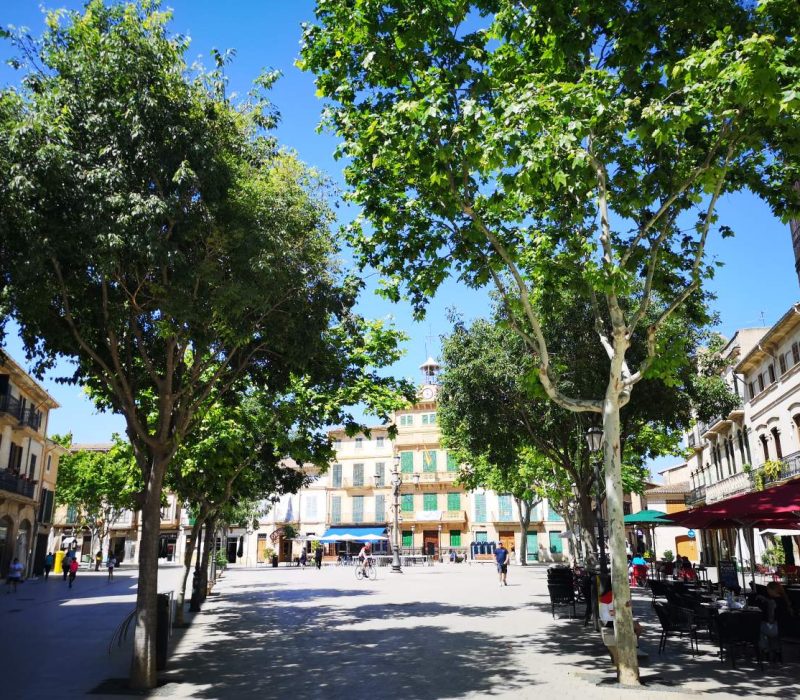
What to expect in Llucmajor
Llucmajor is loved by athletes who have optimal conditions to cultivate their passion here, especially cycling and golf are popular activities in the area. But you can also look forward to beautiful coasts, small beaches and beautiful rural lands.
The town of Llucmajor offers some incredibly beautiful buildings that testify to the prosperity of past times, but also other sights intrude and make Llucmajor worth visiting.
Things to do and see in the Llucmajor area
Llucmajor is an incredibly interesting area to explore, there are just so many points of interest. If you have the slightest interest in architecture, then you are in for treat when visiting Llucmajor, as there is a large number of really great buildings in the town.
CAPOCORB VELL
One of the largest and most splendid examples of Mallorcan prehistory is found in the southern part of Llucmajor, the Capocorb Vell. The entire site comprise a plot size of more than 6,000 m2, exhibiting the excavations of some of the most unique cultures of the island; the Taliotic.
PARISH CHURCH OF SANT MIQUEL
Impressive Baroque basilica built on top of the former primitive Goithic church from the 14th century. The church
CASA CONSISTORIAL
Casa Consistorial is the Town Hall of llucmajor, a stunning four storey building in Historicism and Neo-Gothic architecture. It features unique ornate handrails, as well as Mallorcan marble and other details that makes it worth a stop.
RENT A BIKE AND GO CYCLING
Inca is perfectly located in the hearth of Mallorca, close to mountains and country roads. A particularly popular ride is the one to the Santa Magdalena hermitage situated at the summit of the mountain of same name just north of Inca town.
FOMENT AGRICOLA
This stunning Modernism building with Neo-Gothic attributes was the seat of the Foment Agricola, the agricultural promotion agency. The building was designed by local architect Miquel Salvà, in 1908.
SANT BONAVENTURA
Franciscan church and convent of Sant Bonaventura is a great sight in Llucmajor. The convent feature one of Spain’s most unique collections of grisailles in the cloister, which has been declared Asset of Cultural Interest. Also, the beautiful Baroque portal is worth a picture.
TORRE DE CALA PI
Built in 1663 as a response to the many and ongoing raids of pirates, the watchtower of Cala Pi stands guard from its position on the rocky cliffs of Cala Pi.
MERCAT DES PEIX / PEIXATERIA
Mercat des Peix is a simple yet stylish building which represent both good and bad times in Llucmajor. The building, which is finished in Modernism style, was not finalized with all details as planned due to economical difficulties in the area.
CA SES XILENES
Ca ses Xilenes, or Home of the Chileans, is a beautiful building in the heart of the town which features emblematic Neoclassicism architecture on the main facade.
IMAGE GALLERY
Enjoy some beautiful pictures from Inca
FAQ
Llucmajor is great to visit all year round. The large and versatile area has so much to offer any interest, particularly if you’re looking for an active vacation. You’ll have tranquil countryside, mountainous terrain and beautiful coastal stretches close by anywhere in Llucmajor.
Cala de Cala Pi is the nearest beach from Llucmajor town itself. However, the municipality also comprise the popular summer destination of s’Arenal that has more than a mile of fine grained sandy beachline waiting for you.
Llucmajor is known for its shoe manufacturing. Although not as recognized as Inca, the industry has played a large role in the economic wealth of the area throughout history.
There are markets three times a week in Llucmajor; Wednesdays, Fridays and Sundays. The Sunday market is the biggest and the most interesting to visit.
Llucmajor is very safe to visit.
Events in Llucmajor
Weekly market in Llucmajor
The weekly markets in Llucmajor are held on Wednesdays, Friday and Sunday, whereof the latter being more extensive than the other two. At the markets, you can indulge in a world of fresh fruits, vegetables, oils, meats, cheeses and flowers. Moreover, a great selection of crafts, equipment, clothes, home decor, leather goods etc. is available in the hundreds of stands put up in the heart of the town.
On Thurdays, there is a market in s’Arenal.
Annual events and happenings
July
Sant Cristòfol
In the beginning of July, the beach area of s’Arenal celebrates its patron saint of Sant Cristòfol (Saint Christopher) with a week of fun and cultural activities. One of the amusing celebrations during this week, is the blessing of vehicles. You’ve got a full program of events and activities for all ages, turning s’Arenal into one big community party.
Where: S’Arenal
When: The week surrounding July 10th
Summer celebrations
In July it is time to celebrate the summer, and what better way to have a party than inviting all the tourists visiting during the high season. Six of the beach destinations within the municipal border are together in arranging a series of fun events and activities.
Where: Cala Pi, Tolleric, Vallgornera, s’Estanyol, Maioris, Bellavista
When: Throughout July
August
Summer celebrations of August
Just like the festivities of July, August too is celebrated in the municipality in several places. Fun activities, events, concerts, open-air community dinners, dance parties, water sport conpetitions etc. are just some of the things included in the extensive program of the summer festivities.
Where: Badies, Les Palmeres, Cala Blava, Son Bieló and Sa Torre
When: Throughout August
Festes de Sant Candida
The feast of Candida Maria of Jesus is an important tradition in Llucamjor, as she is the patron saint of the town. For two weeks, the streets of Llucmajor will be full of concerts, exhibitions, shows, gastronomical experiences and much more to celebrate the town. On the feast day of August 9th, there is a mass in the church.
Where: Llucmajor
When: First half of August
September
Fires de Llucmajor
In 1543, the king granted Llucmajor the privilege of holding annual fairs, and the autumn fairs are held every since. This is a series of four fairs held on four on eachother following Sundays starting on September 29th, on the day of Saint Michael. The last Sunday fair, which happens in October, is one of the biggest and most sought for autumn fairs in Mallorca. Every Sunday during this period, you can look forward to a well-organized a fully stacked program of fun and cultural events for all ages.
Where: Llucmajor
When: September 29th and the following 3 Sundays
November
Rutapa Llucmajor
Are you a real foodie? and do you absolutely love tapas? If so, you should come and visit Llucmajor during November when the annual Rutapa tapas festival is held in the town. Most bars of the town participate in creating a tapas el-Dorado of thousands of well tasting variations, each for as little as 3.5 euro, drinks included. This is the perfect opportunity to try some of the tapas you have been curious about when looking down the menu cards in the restaurants, or let yourself be seduced by colors and scents of the unknown.
Where: Llucmajor
When: November
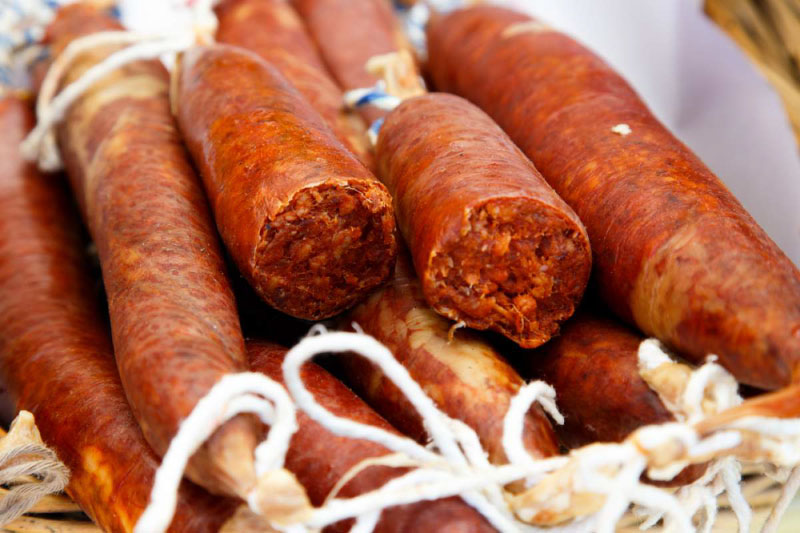
Support Local
Supporting local communities during your travels can have a profound impact. Stock up with groceries locally, stop in an artisan shop or enjoy a refreshment at a restaurant or bar. Now more than ever, these small businesses need support from travelers near and far.
Get to know Llucmajor
A bit of history of Llucmajor
Llucmajor is a town and municipality located in the south-eastern region of Mallorca called Migjorn, which also comprise the municipalities of Campos, Ses Salines, Santanyí and Felanitx. The municipality is one of the larger of the island covering a surface of 32.704,78 ha, with 8.140,60 of those being protected. The population centers iclude Llucmajor town, Arenal, S´Torre, Sa Badia Gran, Badia Blava, Puig de Ros, Palmeres, Maioris Dècima, Son Verí Nou, Tolleric, Cala Pi, Estanyol de Migjorn, S´Bellavista and Cala Blava. The total population is 36.358 inhabitants as of 2018.
History of Llucmajor
In this section, you will learn about the key periods in the history of Llucmajor, who was here and what happened. REegarding the name of the municipality, it was created by the two words “lucus” and “maioris”, meaning “forrest” and “great/big” respectively.
- Prehistory & Talaiotic culture
- Under Moorish territory
- The Christian reconquest
- The foundation of the town
- Battle of Llucmajor
- The revolts of the modern age
- The threat of the Ottoman and pirates
- Highlights of the 17th to 19th century
- Economical changes
Prehistory and Talaiotic culture
The first vestiges of human occupation within the current municipal border of Llucmajor dates from the 3rd millenium BC, a time in the Balearic Islands known as the “pre-Talayotic”. This prehistoric period was characterized by habitations in artificial and natural caves, as well as burial caves. Some of the caves that has been used the most, are those of Son Hereu, Llucamet, s’Àguila, Son Cardell, Bennoc, Son Mendívil and Son Mulet.
In the late Bronze Age, the Talaiotic culture arrives in the Balearic Islands, a culture unique to this archipelago. It became known in the eastern and southern areas of the Mediterranean, that the lands of current central and western Europe were rich on metals. This triggered traders and merchants from ancient Greece and Carthage to cross the sea in search for these metals, and, colonize strategic areas.
A great example of colonization, is the complex of Capocorb Vell in the southern part of Llucmajor, one of the largest and best examples of the Talaiotic culture in Mallorca. With the arrival of the new colonizers from the ancient worlds, the societal structures changed from groups of shelters and huts to villages and fortifications. The Talaiotic culture got its name because of the tower-like constructions built for lookouts. In Catalan, “talaia” means “watchtower”. This also tells us about the introduction of a whole new philosophy behind construction of structure, from being solely used for sheltering and habitation to become defensively oriented.
The colonizers mixed with the indigenous people, and with the introduction of a defensive and military oriented mindset, the Balearic foner was born. The foner was a warrior with unique capabilities of slinging, hence popularly known as “slingers”. The Balearic foners was mentioned already in the Sicilian wars fighting for the Phoenicians, later in the Punic Wars on same side. Hannibal, one of the greatest men of war of our times, gave the foners extra credit in his victories and they was to be protected at all causes, a kind of secret weapon. What made the foners so exceptional, was the accuracy and distance of their projectiles. Not only were they great weapons against infantry, but they could also break ships.
Under Moorish territory
In 902, Mallorca was conquered by Issam al-Khawlaní – in Arabian عصام الخولاني -whom found the archipelago by accident when he needed shelter during a storm on a pilgrimage to Baghdad. He returned to the islands in various raids, and finally, he convinced the Emir of Cordoba that the islands would be a great base for launching naval attacks on trade ships in the Mediterranean. al-Khawlaní was in charge of the conquest himself, and in return, the Emir granted him the title of walí, a governor. He then founded Madīna Mayūrqa, the Almudaina palace, installed baths, water transportation systems and erected mosques.
The island was divided in roughly twelve administrative districts, jurisdictions if you will, to make it easier collect taxes and keep order. A district was called a “Juz’” (plural. ajzà) This was the first time Mallorca was introduced to a structured society with a fiscal system. The current area of Llucmajor came under the district called “Juz’ de Montuy”, which also comprised current day Montuïri and Algaida.
Shortly after the conquest of the islands, tribes from North Africa and the eastern parts of the emirate came to settle in the new territory. The clans that arrived was already organized and structured, they were bound together by kinship. They settled in farmsteads, the so-called “alquerías”, scattered all over the island and gave them names according to their tribe. Typically, the Moors would put a “Banu”, meaning “children of” and translated to Catalan being “Beni” or “Bini”, in front of the clan’s name, which would, when put together, become the name of the farmstead or place i.e. Binissalem (Children of Salim).
Within the municipal border of current day Llucmajor, one of the major farmsteads was the one of Binilagant located north of the current town.
The Christian reconquest
In 1229, Jaume I of Aragón landed with his 27,000 men in the bay of Santa Ponca with a mission to kill and destroy all Muslim resistance island. It took his troops nothing more than about 3 months to defeat and take Madīna Mayūrqa, a triumph he could celebrate on December 31, 1229. It took Jaume and his almogavars to hunt down any Muslim resistance on the island, whereof the Santueri fortress in Felanitx was the last. Following the conquest, Jaume parted the lands of Mallorca and divided these among knights, counts and bishops, who then gave or sold the lands to their men, if not kept it for themselves.
The lands of Montuïri and Llucmajor fell in the hands of Ramon de Santmartí, a nobleman who fought in the conquest along with his family members, Pere de Santmartí, Ferrer de Santmartí and Guillem de Santmartí. Ramon de Santmartí was also granted houses in the Ciutat de Mallorca (Palma), lands in Petra and in the mountains.
The foundation of the town
In 1276, Jaume II of Mallorca, successor of Jaume I, inherited the kingdom of Mallorca. In order to attract new settlers, he had a set of ordinances conducted which he promulgated in the year 1300. These ordinances established twelve towns in Mallorca, including Llucmajor, which at that time was already a small village.
Each settler had to purchase 3.55 ha of arable land, 7.10 ha of garrigue and 1,775 m2 of plot in the new town, where he had to build a houses and move to live here within the next half year. For a possession like this, the settler would pay a tithe and a cash census (tax).
The ordenadors (the person in charge of effectuating the ordinances), were required to designate 355 ha of land and 710 ha of garrigue. The owners of these lands were then obliged to establish them to the new settlers, the so-called “acaptadors”, in exchange for a tax paid in metal determined by the ordenadors.
With the new ordinances also declared the premises of what should be included and the delimitation of the perimeter of the town and the affected areas. Previous design patterns of small villages and functional delimitation of the arable territory, as well as the extent of garrigues, determined the location of the town.
In regards to the creation of the town, the width of the streets was set to measure 6.3 meters, the center of the town should be enforced by a protective wall or other fortified enclosure, and, the total perimeter of the town was expected to occupy no more than about 17.76 ha.
It was the ordenadors who were responsible for defining the space needed, to drawn the streets and make sure to provide necessary infrastructure such as water supply in the community spaces. Surrounding the fortified town center, several neighborhoods would by established.
Battle of Llucmajor
On October 25th, 1349, Mallorca loses its independence as a private kingdom and is annexed under the Crown of Aragón.
In 1341, Peter the Ceremonious, king of Aragón, accumulated legal grievances against his brother-in-law, Jaume III of Mallorca, accusing him of printing Barcelonian currency in Perpignan. Jaume appeared in front of the court in Barcelona in 1342 where the situation was aggravated, as Jaume now accused Peter of wanting to abduct him. In 1343, Jaume III was found guilty of charge and was sentenced to hand over his assets and states. In May the same year, Peter “invaded” Mallorca in compliance with the sentence and defeated Jaume whom fled to Roussillon and Sardinia. Another military campaign in 1344 set Jaume further back, as Peter’s troops took control Roussillon, Menorca and Eivissa (Ibiza), still in compliance with the sentence of 1343, In July 1344, Jaume surrendered to Peter on the condition that his life was spared and he was given his freedom, as well as keeping Montpellier as the last state in his possession. Jaume then took refuge in the papal court in Avignon.
However, Jaume was not done, he was determined to win back Mallorca at any cost. For this purpose, he sold Montpellier to the king of France for 120,000 gold coins with the blessings of Pope Climent VI.
With his first payment for Montpellier, Jaume assembled an army of mercenaries and set sails for Mallorca in the fall 1349. On October 11, he disembarked his troops at the beach of Cap de Formentor and on the beach of Albercutx in the bay of Pollença, a total of 300 horsemen and 700 infantry. Jaume met resistance in Pollença, that held stand for two whole days before he broke through an besieged the town. Jaume’s hope was initially, that the people who had fought Peter’s troops in the battles of Castell del Rei, in 1343 would support him, but they had turned their backs on him, which led to battles in the area. Following the defeat of Pollença, Jaume and his troops invaded Alcúdia and later Muro, both towns suffered great destruction of both buildings and fields.
On the 19th of October, Jaume set course towards Ciutat de Mallorca (Palma), but met strong resistance in Inca. This resistance caused him to change course and head to Sineu, where he stayed for two days, until October 21st.
While all this was happening, the rest of his army, 8 galleys carrying 100 horsemen and 2,300 infantry, sailed towards Ciutat de Mallorca under command of Admiral Lucià de Grimalt. They arrived in Portopí on October 21st, where they were met by a fleet of Riambau de Corbera, governor of Sardinia, who hunted Jaume’s troops out of the bay.
On October 22nd, the two governors, Gilabert de Centelles (of Peter IV) and Riambau de Corbella, left Ciutat de Mallorca to attack Jaume in Sineu. However, Jaume was heading towards Porreres, so the two governors turned towards Algaida to cut off the roads to Ciutat. The two armies were just 5.5 km from each other, when Jaume decided to turn and set course towards Ciutat. He chose to spend the night in Llucmajor between the 24th and 25th, while at the same time, Gilabert de Centelles did the same.
The battle of Llucmajor took place Sunday morning on the 25th of October on the outskirts of the town, at what we know as “es Camp de sa Batalla” (Field of the Battle). The clash lasted all morning until Jaume could not hold stand anymore, and an Almogàvar from Borriana cut off his head.
Following the battle, the decapitated body of Jaume III was put to rest in the parish church of Sant Miquel in Llucmajor, along with the body of his brother Pagà. In November, his body was transferred to Ciutat and later to Valencia where he was buried. His brother remained in Sant Miquel until 1368 when he transferred to the La Seu cathedral. In 1905, the body of Jaume III was again transferred to La Seu.
Post the reincorporation of the Kingdom of Mallorca into the Crown of Aragón, the Kingdom of Mallorca kept its name, its institutions and constitutions until the promulgation of the Nova Planta decrees of 1715.
In the late 14th century, John I of Aragón came and stayed in Llucmajor taking refuge from the plague ravaging in Catalonia. In 1386, a Gothic church is erected in the town, in which famous preacher Vicenç Ferrer visited.
The revolts of the modern age
In the middle of the 15th century, a serious conflict marked an entire century in Mallorca including Llucmajor. Imbalance in tax obligations between the citizens of the Ciutat and the peasant of the rural area, as well as rumors of corruption by administrators and nobles caused a rebellion to rise against the authorities. What aggravated the situation further, was when a declaration of properties and estates was to be conducted, documenting the ownership of the landowners, a so-called “capbreu”. Every landowner was obliged to show up with documentation proving their rights of usage of the lands they possessed. Many small landowners and peasants either did not have a such document or had lost it.
These things together gave rise to the first real social conflict in Mallorca; Revolta Forana (Revolt of the Foreigners). The rural areas outside the borders of Ciutat de Mallorca (Palma) were known as the forans (foreign areas). Plagues, droughts, bad harvests and the wars in Naples had all contributed to poverty in the agricultural sectors, causing landowners to sell their properties which were acquired by wealthy citizens of the capital.
As the capbreu was to be conducted, the people responsible for writing it, were assaulted in Manacor and Petra, the ignition of the rebellion. After several failed attempts to force their way to the governor in the capital, the governor instead initiated a great repression upon all supporters and participants of the rebellion. However, the rebellion returned with a new leader, Simó “Tort” Ballester, whom succeeded in negotiating with the governor a year later after a siege of the Ciutat. The governor instead turned the conflict into a war ordering his lieutenant Jaume Cadell to gather an army and put the rebellion to an end.
As this attempt failed and the rebellion continued to siege entire villages and towns all over the island, the king finally sent saccomanis (Italian mercenaries) to the island to crush the rebellion. Following the defeat, an increased repression was put on the participaters and supporters of the rebellion, as well as on the families of those men who had died. Simó “Tort” Ballester was hung, dragged and quartered.
Noteworthy here, is that Llucmajor was one of the towns that refused to raise the flag of the rebellion staying true to the king.
In the beginning of the 16th century, namely in 1520, a new civil war broke out in Mallorca; Revolta de les Germanies (Revolt of the Brotherhood). The Brotherhood, was the artisans guild that demanded public debt erased. Basically, this revolt was a continuation of the Revolta Forana, it was the same issues which caused disputes.
Blood was shed all over the island for nearly two years, until King Carlos sent his royal troops to end the situation. The consequences was once again a hard repression on the people and the families of supporters and participants.
The threat of Ottoman and pirates
The 16th century was not just marked by the revolt of the artisans, because in the same century the Ottoman empire from the east began its campaigns to capture the archipelago in the Mediterranean. The towers of s’Estelella, es Blanc, es Enderrocat and Cala Pi, are all evidences of these threats.
The Ottoman navy paid Berber privateers to assist in attacking the coastlines of Mallorca. Pirates would camp on the island of Cabrera from where they mobilized their raids against the southern coasts. One of the first towers to be erected, was the one of Torre de s’Estalella (1577) followed by the one of Cap Blanc (1579), then of Cap Enderrocat (1584) and finally the one of Cala Pi (1663).
The function of the towers was to observe the bay, and when an enemy ship was spotted, a smoke signal and waving flags communicated to the neighboring towers until the alarm reached the town. Many of the rural estates between the coast and the town were fortified and had watchtowers built on top of them.
Highlights between the 17th and 19th century
Around 1608, the Franciscan monks established the convent of Sant Bonaventury in the heart of Llucmajor. They arrived already back in 1576, where they from another location gave alms and provided help for the poor and sick. After a short period of time, the monks had become a great part of the culture of Llucmajor and were granted permission to built the current convent in 1608.
In 1836, the convent of Bonaventure was subject to the great ecclesiastic confiscation initiated by prime minister of Spain Juan Alvarez Mendizabal. The reason was the First Carlist War of Spain, when supporters of Carlos and supporters of Isabel clashed all over Spain on the question of who should become the next regent. To raise money, the prime minister confiscated most monastic properties in Spain and auctioned them to private investors to create a new middle class of landowners, and thereby strengthen the economy and cover for the costs of the war in favor of Isabel.
In 1781, the construction works of a new Baroque style parish church began. The first phase was projected by A. Mesquida and Fray Miquel of Petra. Later, in the 19th century, Isidro González Velázquez and Joan Sureda modified the church and added a neoclassical character.
Economical changes of the 20th century
Llucmajor has always been an agricultural area with its main activities in livestock and grapevines. Especially in the 19th century, the Mallorcan wine production was sought for due to the outbursts of phylloxera in France, Spain and Italy. However, the phylloxera eventually came to Mallorcacausing all vineyeards and grapevines to be destroyed as there was no remedy.
While many of the former landowners of vineyards emigrated to Latin America to seek new fortunes, the remaining population turned to the shoe industry. Llucmajor soon turned into a great production center of quality footwear and had great markets in America and in Asia. However, as the war with America broke out, this industry came to an end. As a consequence of the wartime, in 1898, the fortress of Cap Enderrocat was created as a part of the defensive system of Palma, and was the largest fortress on the island. Since the Spanish Civil War ended in 1940, the fortress was no longer needed and experienced a decline in state of condition. Today, it has been completely renovated and restored, and turned into an authentic luxury hotel.
When tourism was introduced in Mallorca in the mid 1950’s, Llucmajor too saw the potential of this new industry, which gave rise to the great holiday areas of s’Arenal, Cala Pi, Cala Blava, Badia Gran, Vallgornera and 13 other holiday destination within the municipal border.
Practical Info
Useful Numbers
Emergency: 112
National police: 091
Local police: 092
Guarda civil: 062
Fire: 080
Maritime emergencies: 900 202 202
Tourist Office: +34 971 660 050
Public Transport
Bus lines: 503
Power Supply
220V
